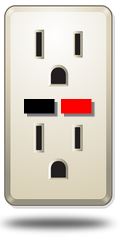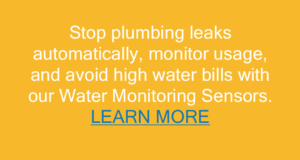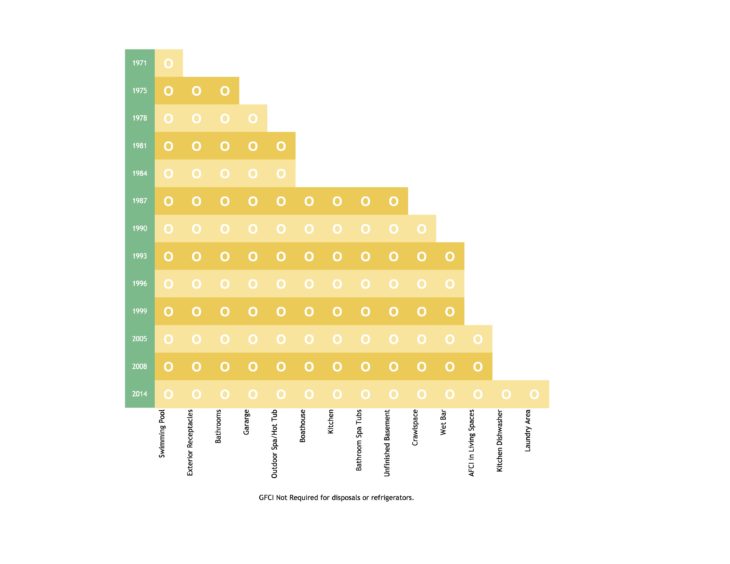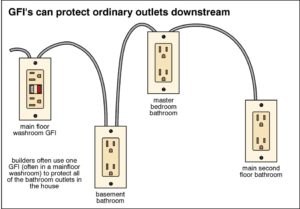When and Where are GFCI Receptacles Required?
When and Where are GFCI Receptacles Required?
Saying that disagreements can arise over a home inspection is an understatement. One item that can cause frustration is the Ground  Fault Circuit Interrupter or GFCI. A GFCI is typically a receptacle with small buttons on it that usually say “Test” and “Reset”. It can also be built into a circuit breaker that is installed in an electric panel.
Fault Circuit Interrupter or GFCI. A GFCI is typically a receptacle with small buttons on it that usually say “Test” and “Reset”. It can also be built into a circuit breaker that is installed in an electric panel.
Home inspectors test the operation of GFCI’s as part of their evaluation. They may also recommend the installation of GFCI receptacles near plumbing fixtures. But they weren’t always required. So how can you resolve disagreements about the presence or absence of GFCI receptacles? Let’s first talk about safety, then the requirements.
What is a ground fault circuit interrupter (GFCI) anyway?A “ground-fault” is an unintentional flow of electricity between a source of electrical current and a grounded surface. Without protection, electrical shock can occur if a person comes into contact with an energized part. For example, if a person is holding a damaged electrical cord from a hair dryer and touches a plumbing fixture, they could be electrocuted. They would certainly get a painful shock.
protection, electrical shock can occur if a person comes into contact with an energized part. For example, if a person is holding a damaged electrical cord from a hair dryer and touches a plumbing fixture, they could be electrocuted. They would certainly get a painful shock.
A GFCI receptacle constantly monitors an electrical circuit. If it detects even a slight flow of electricity to a grounded item, it immediately shuts off the flow of electricity. This protects people from electrocution. It is particularly important to protect people where they could come in contact with exposed grounded items such as plumbing fixtures.
How is a GFCI different from a regular circuit breaker or fuse?![]() If too much electricity flows through a wire, it will get hot. Sometimes it can get hot enough to start a fire inside the walls of a house. Traditional circuit breakers protect your house from fires by shutting off the flow of electricity to a wire when there is too much demand for electricity. This can happen when too many items are plugged into a circuit. That’s why a power strip can be dangerous if there are too many electric items plugged into it. Circuit breakers do not protect people from electrocution. Their purpose is to protect you from a fire.
If too much electricity flows through a wire, it will get hot. Sometimes it can get hot enough to start a fire inside the walls of a house. Traditional circuit breakers protect your house from fires by shutting off the flow of electricity to a wire when there is too much demand for electricity. This can happen when too many items are plugged into a circuit. That’s why a power strip can be dangerous if there are too many electric items plugged into it. Circuit breakers do not protect people from electrocution. Their purpose is to protect you from a fire.
Related Article: New 'AFCI' Circuit Breakers Prevent House FiresWhen and where are GFCI receptacles required?
GFCI receptacles were required in houses starting in 1971. Originally they were only required at the exterior of the house and by swimming pool equipment. Over the years, GFCI receptacles have been required in more locations such as garages, bathrooms, kitchens, etc. The following table applies to most municipalities, but some local codes may be different. Please check with your local building department.

In most cases, no. For example, all of the bathroom receptacles throughout a house can be protected by one GFCI receptacle. This is true for the receptacles at a kitchen counter that are required to be GFCI protected. You may only see one GFCI receptacle, but all down-circuit receptacles can be protected if installed properly. The GFCI receptacle simply needs to be located closest to the breaker on that circuit. It will provide protection for all of the down-circuit “ordinary” receptacles.

In an older home, there may be no requirement for GFCI’s to be installed. The seller is not required to upgrade the receptacles unless the electrical system has been modified. So if the kitchen in a 1950’s house has been remodeled, and receptacles have been added or moved, they must be upgraded to GFCI receptacles if they are within 6 feet of a plumbing fixture. This applies to bathrooms too. So when your home inspector suggests upgrading certain receptacles to GFCI receptacles, please know that he has your safety in mind. The seller may not have to upgrade the receptacles, but you should do it for your family’s safety.


